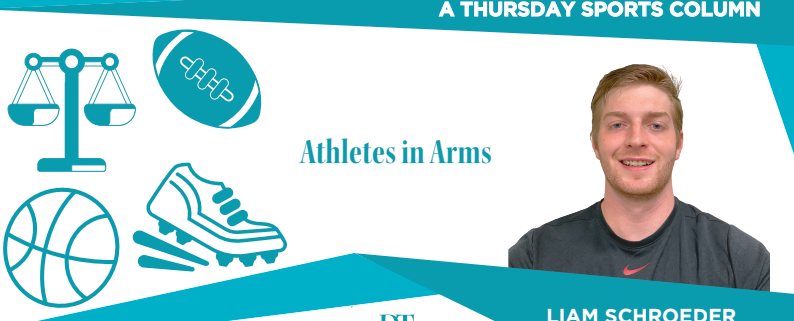Athletes in Arms: What rap has to prove about sports and the United States
Vinyl is crackling under the quaint melody of a piano. Suddenly, a heavy guitar riff takes over as a stern voice says, “Look, If you had one shot or one opportunity / To seize everything you ever wanted in one moment / Would you capture it, or just let it slip?”
This iconic intro coming from Marshall Mathers, known as Eminem or Slim Shady, precedes his song “Lose Yourself” in which he raps about the intense pressure that comes before a performance. This sense of pressure is born out of the need to perform at the absolute highest level, out of fear of failure and subsequent rejection, a common theme among both rappers and athletes alike.
“Lose Yourself” may be the shining example of a song to fire you up for a game. When you find yourself looking to enter a competitive mindset, hip-hop and rap may be a familiar way to get you there, but that may be because it has been competitive from its origins decades ago.
From the era of Afrika Bambaataa and Grandmaster Flash of the early 1980s, competition among artists has always been embraced, especially among the elements of MCing (rapping) and B-boying (dancing). Hip-hop artists saw head-to-head competition as a useful way to express themselves through their art form, which was often reflected in their lyrics.
This tradition of competitiveness still lives today in contemporary lyrics. Lil Baby’s “Sum 2 Prove” includes the lyrics “I was sittin’ in jail, they ain’t look out for me / Ones who need me, the same ones that doubted me / I been handlin’ my own, they can vouch for me / Head way down with me, know that she proud of me / Turn the heat up, ain’t nobody hot as me.”
Lil Baby infuses his raps with many of the same themes athletes sympathise with. Within these verses, concepts of hard work, failure and success, dedication and pride all come across as motivating factors for the rapper. Whether it be before practice, weights or a game, these are the same themes that athletes resonate with in their respective careers.
Since 2017, hip-hop and R&B have risen to become the most popular genre in the United States, according to a Nielsen Music Report. I have seen rap as the preferred sound to my pregame ritual in any sport since I began to play basketball years ago. Now rap and sports have become intertwined to a point where both draw inspiration from one another in many instances. Whether it be artists referencing the names of athletes in their songs or athletes endorsing the work of their favorite artists, both have shown an appreciation for the other.
The feelings of hard work and creating opportunities for oneself transcend sports just as much as they do hip-hop. These feelings conveyed through music have been used to express the struggle of the Black community in the United States. These themes are most notably seen in the work of artists like Kendrick Lamar, J. Cole, etc.
They can also be seen more subtly in the songwriting of artists like Gunna as he says in “DO BETTER,” “All black, they can’t see me in the Ghost / Make it back, all I ever needed was hope … I got to be the son, I got to be the one / Nah, I can’t be the one they callin’ a joke (nah).”
Although the song has a smooth melody and a steady beat, Gunna’s synthesized voice delivers a message of Black success through the image of a Black man in a Rolls-Royce Ghost. Much like Lil Baby and artists of similar standing, Gunna touches on the need for hope to increase their sense of belonging and respect within the music industry.
Just as messages of hard work can be translated to athletes, they can be directly heard as inspiration by people of color in the United States. Although athletes sympathize with the verses of rappers explaining how the deck of cards may be stacked against them, this is the reality for many people of color in the United States. Hearing stories of Black success and overcoming racial barriers in music enables young people of color to have multiple role models to draw inspiration from.
Hip-hop and rap may be a relatively new genre but its artists have come to unite much of the United States through not only sound but also the messages in songwriting. Not all lyrics focus on struggle, but with the hopeful message of hard work that many artists express, it can be seen as the perfect tone for the United States in this time.
As I seek focus and adrenaline before a match in my “A different animal and the same beast” Spotify playlist, not only am I listening to songs with a beat per minute count that will get my heart pumping, but songs with lyrics that will center my thoughts on success. Not only can rap provide an athlete the drive they need to succeed, but also the drive that many need to create opportunities to succeed. In that way, rap is truly a great American genre.
Liam Schroeder is a junior writing about sports and social justice. He is also a middle blocker on the USC men’s volleyball team. His column, “Athletes in Arms,” runs every Thursday.

